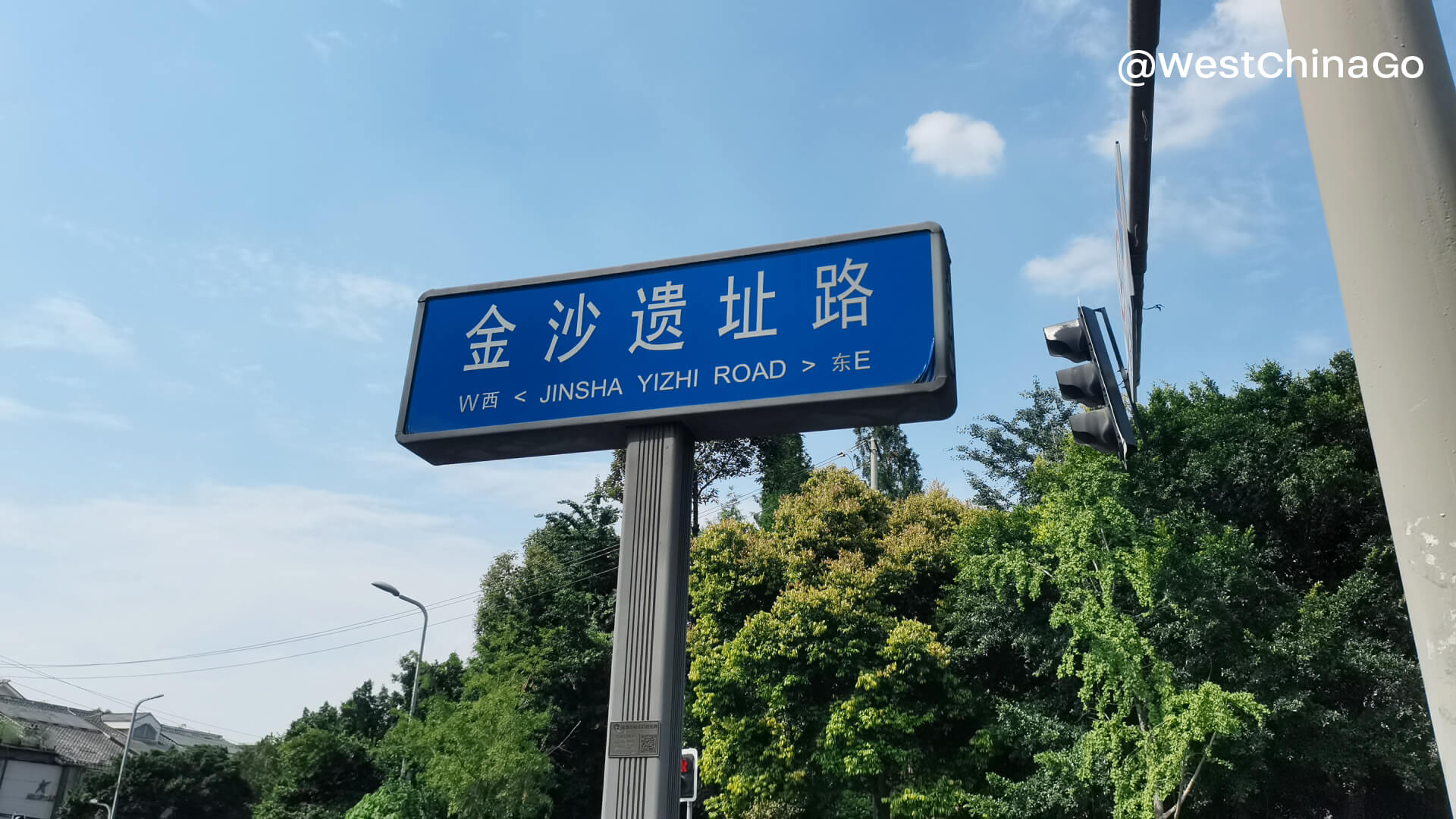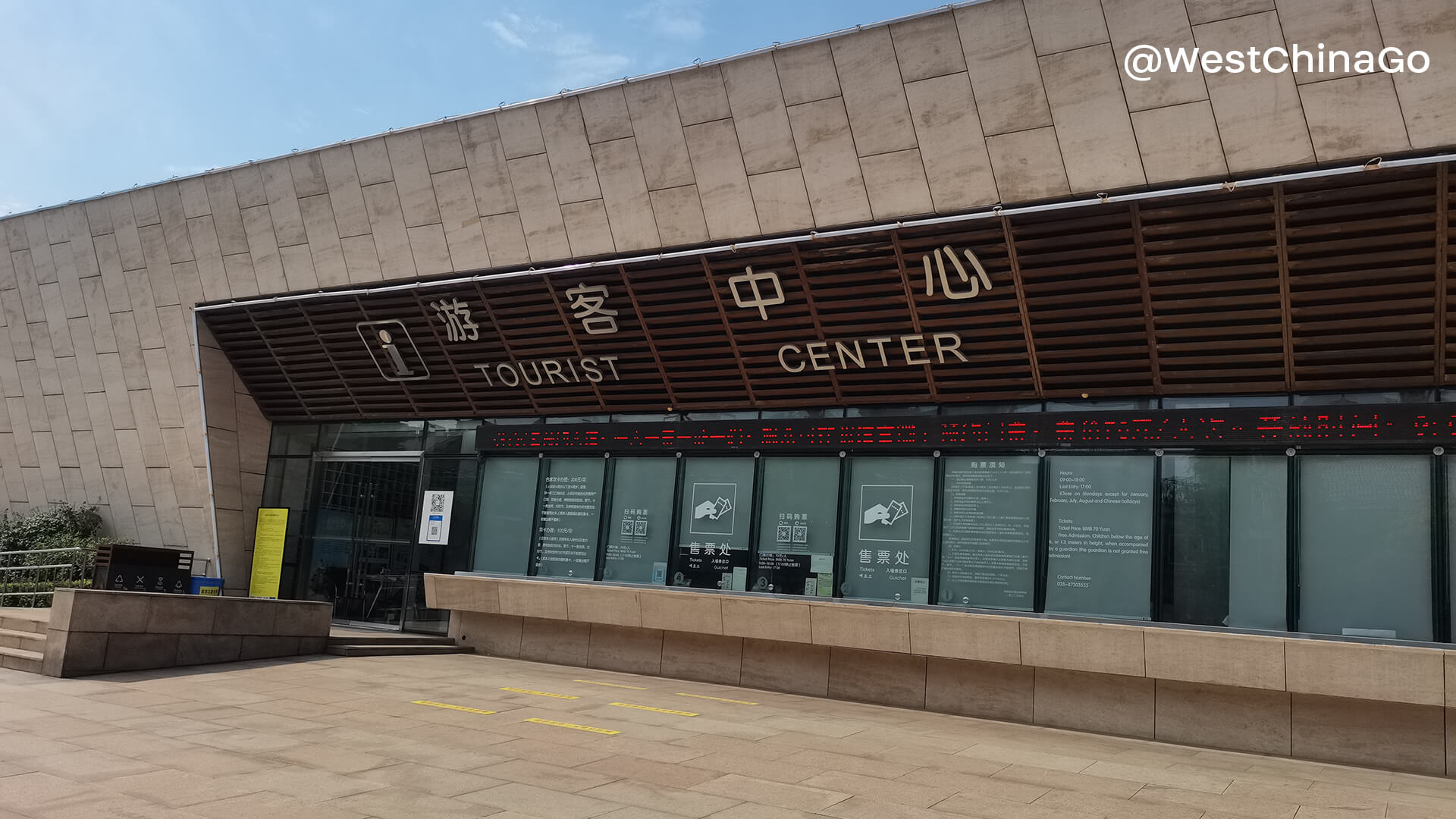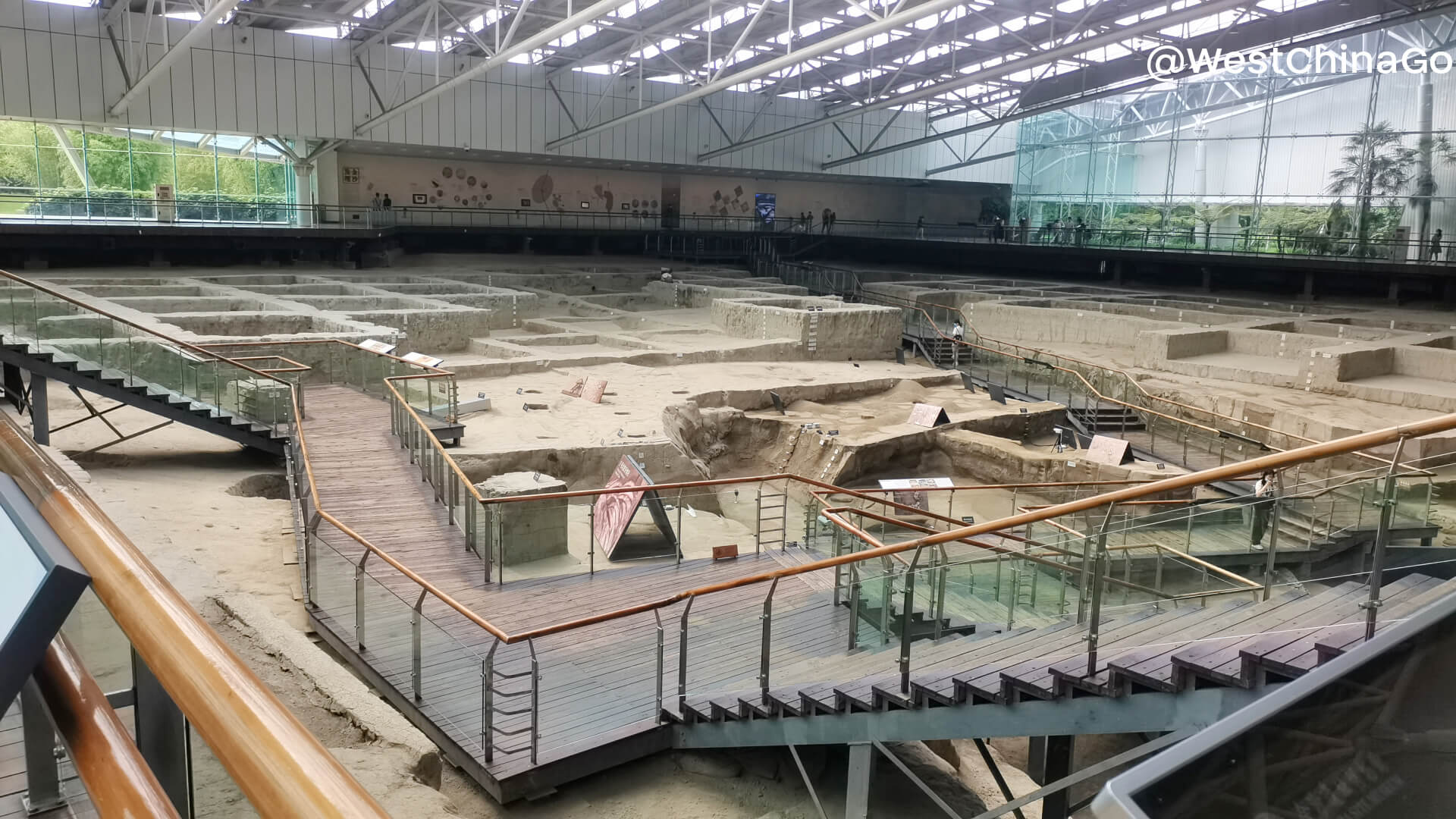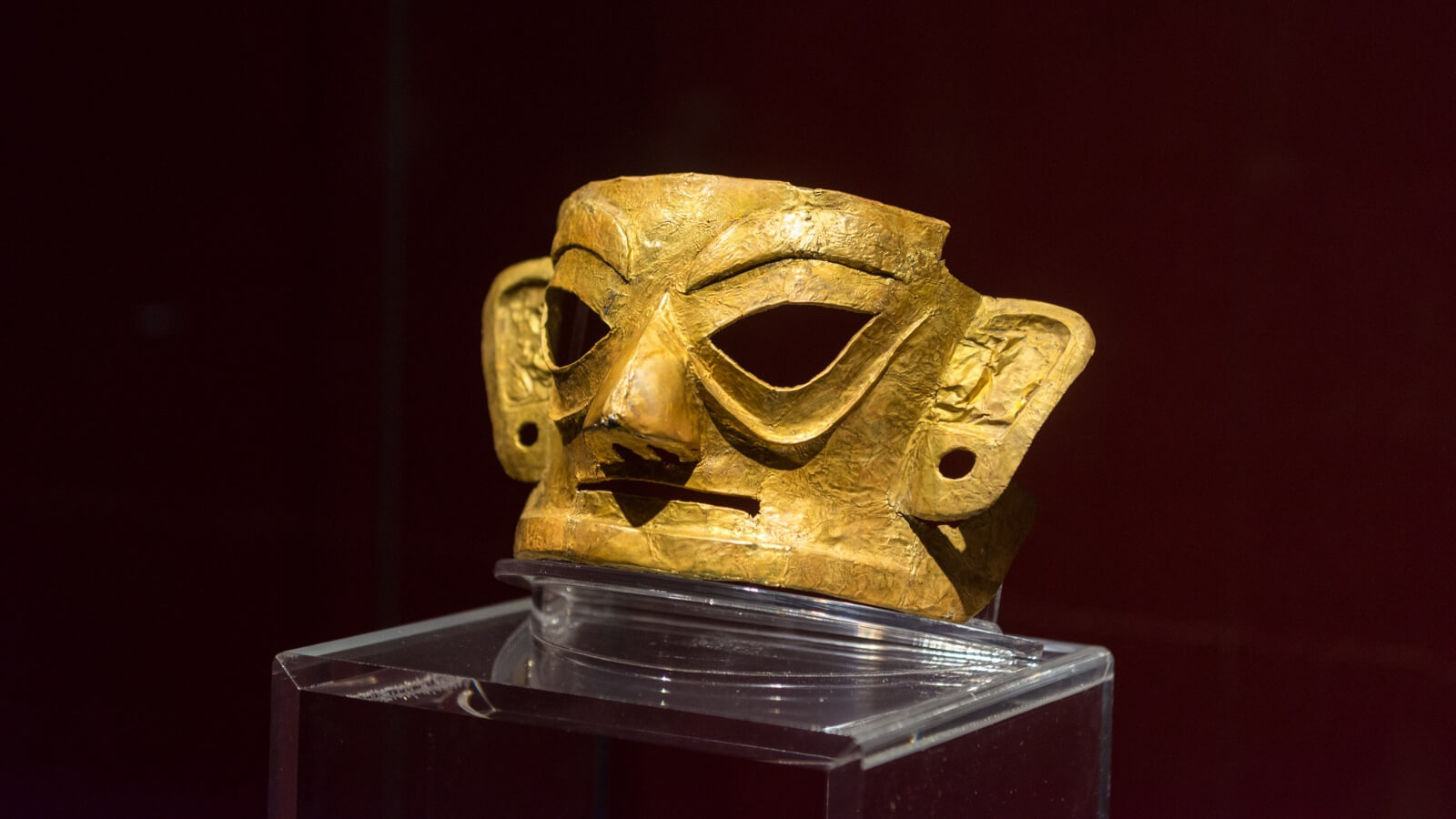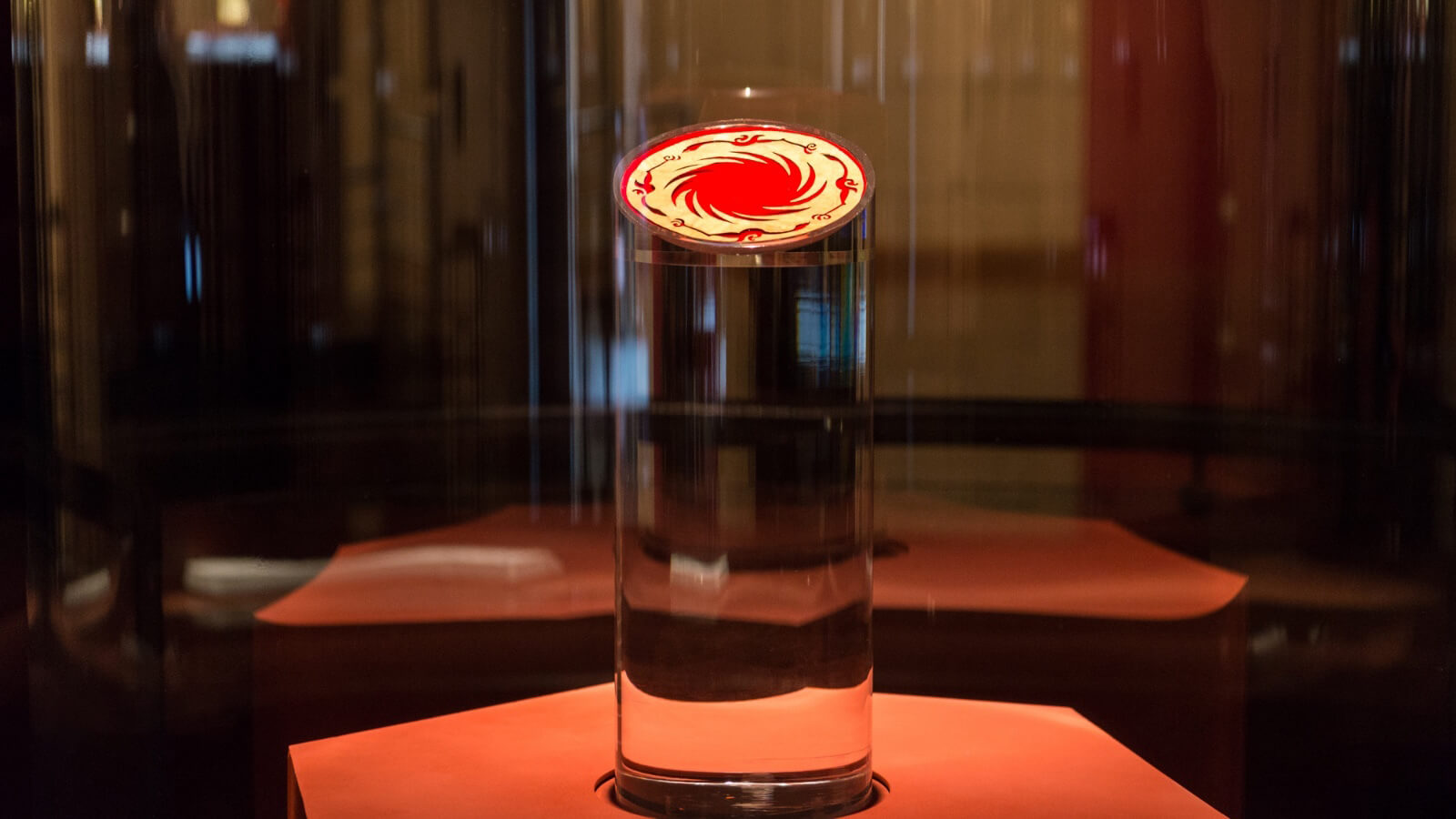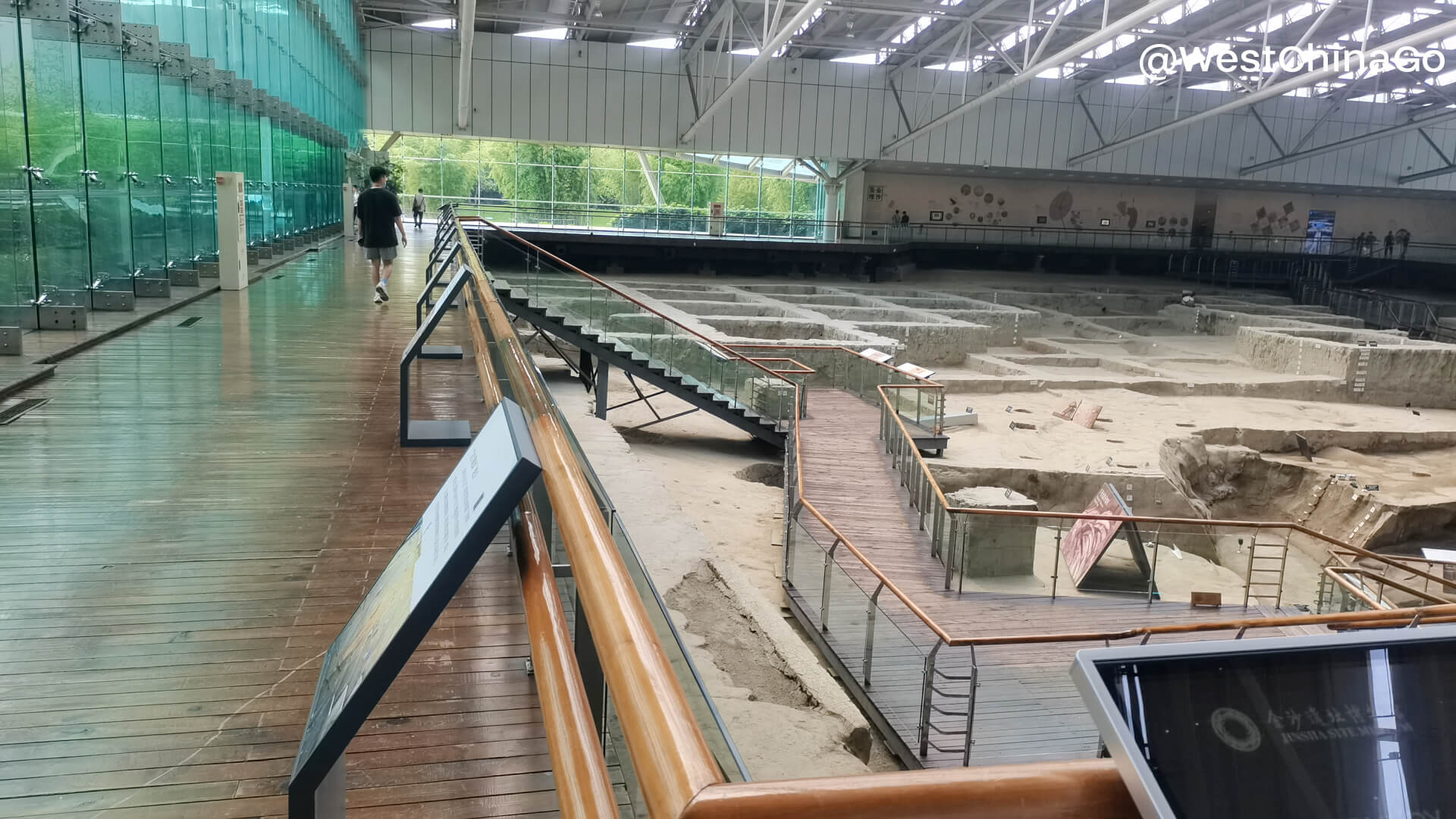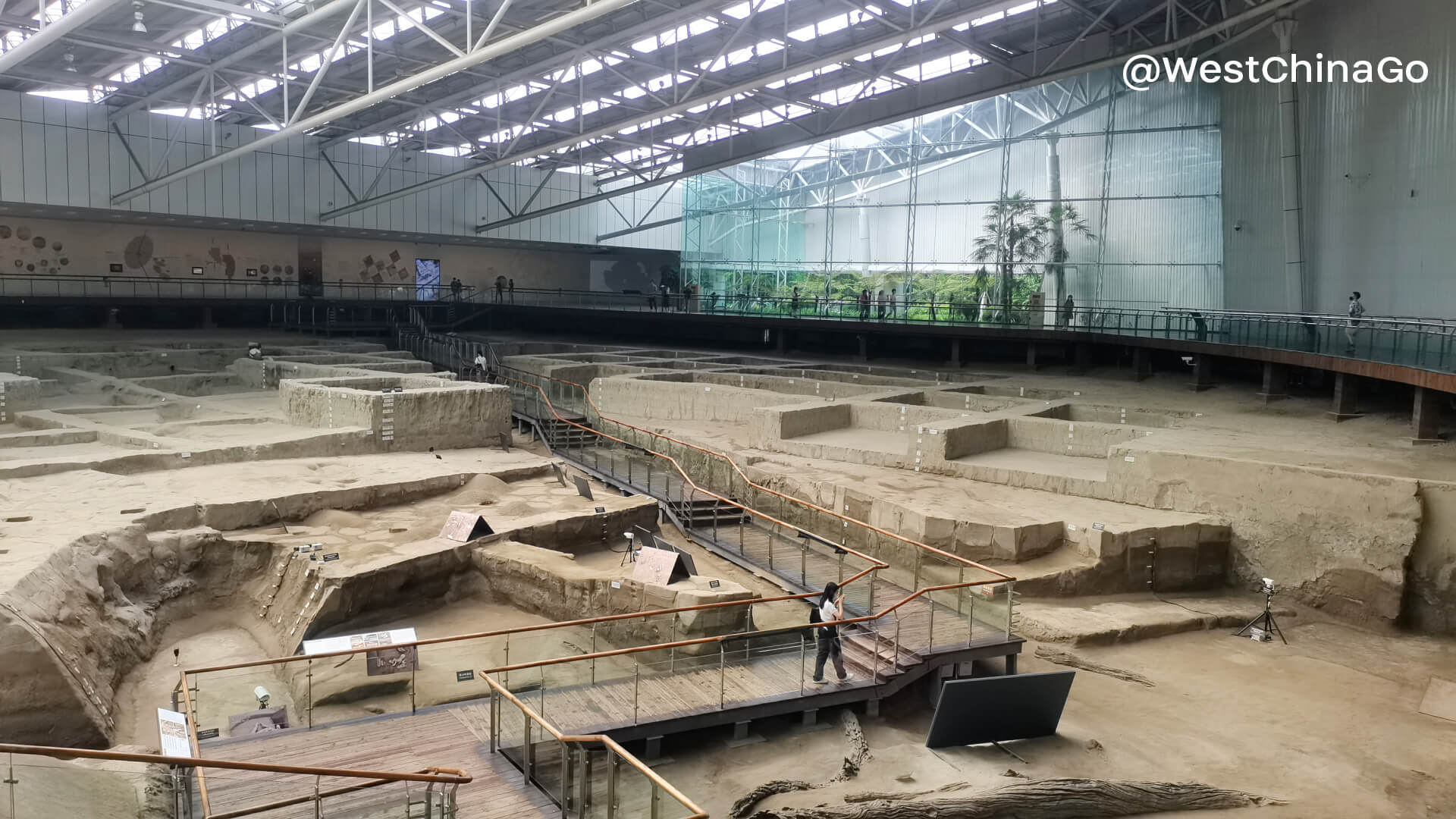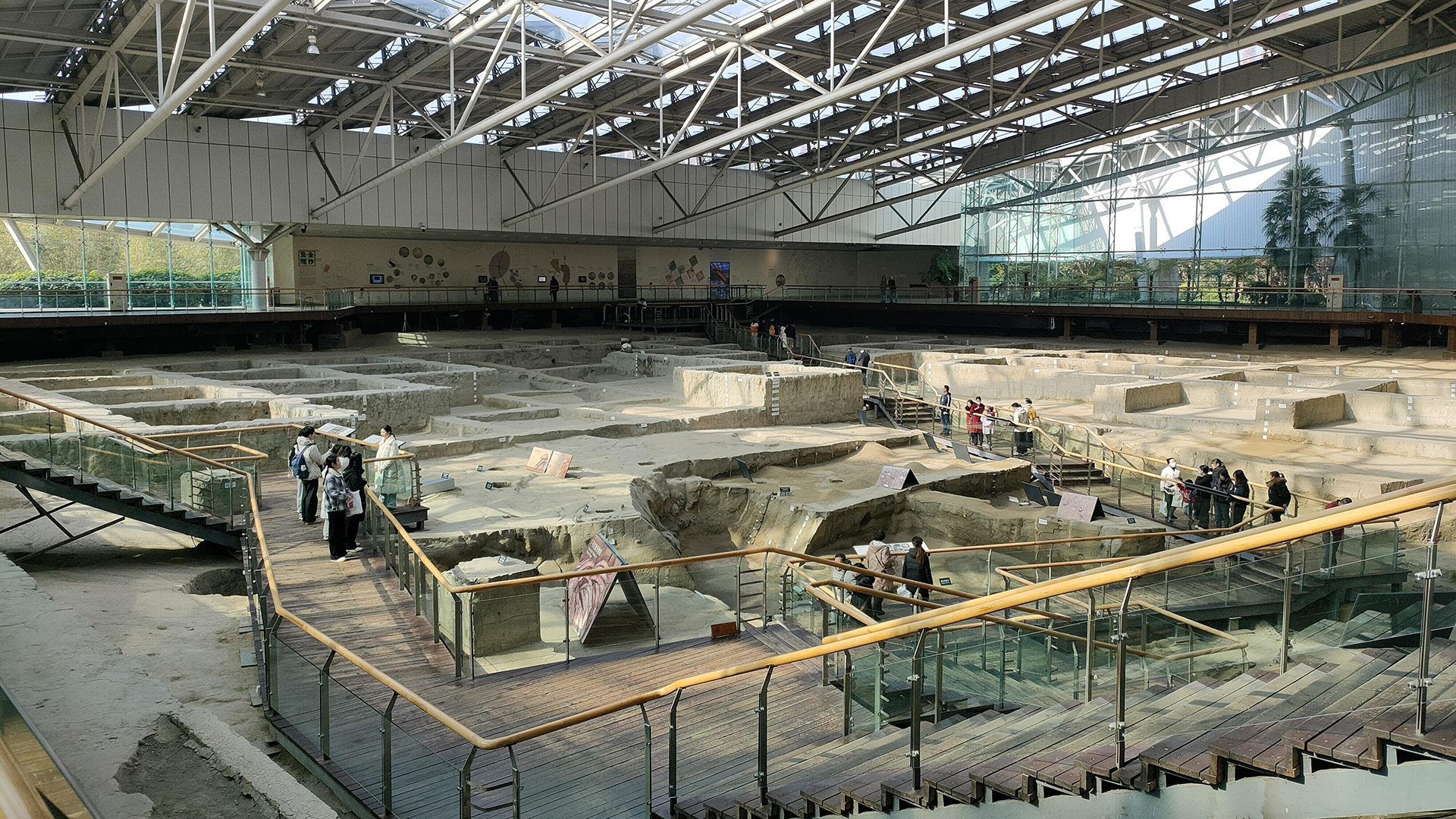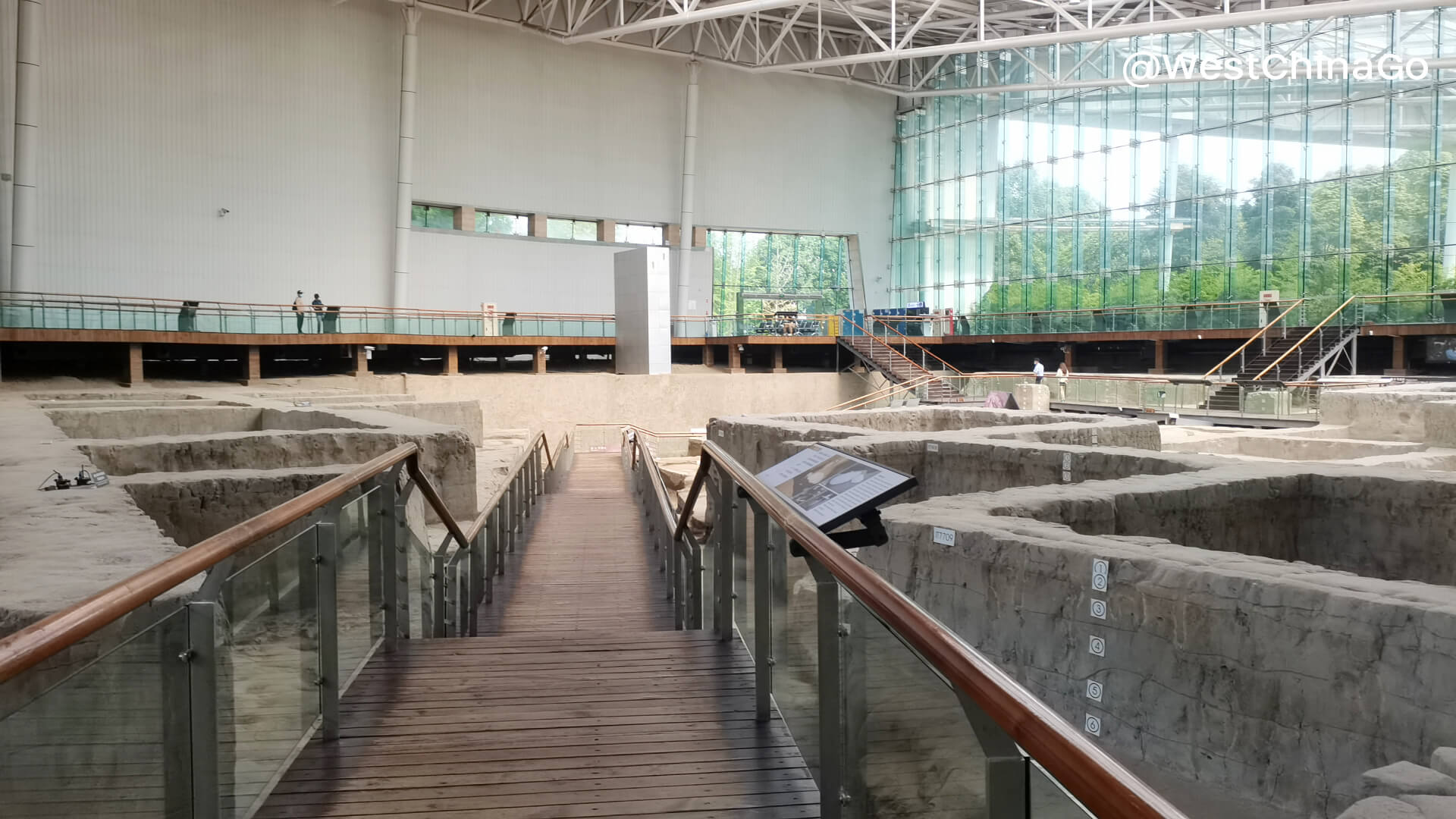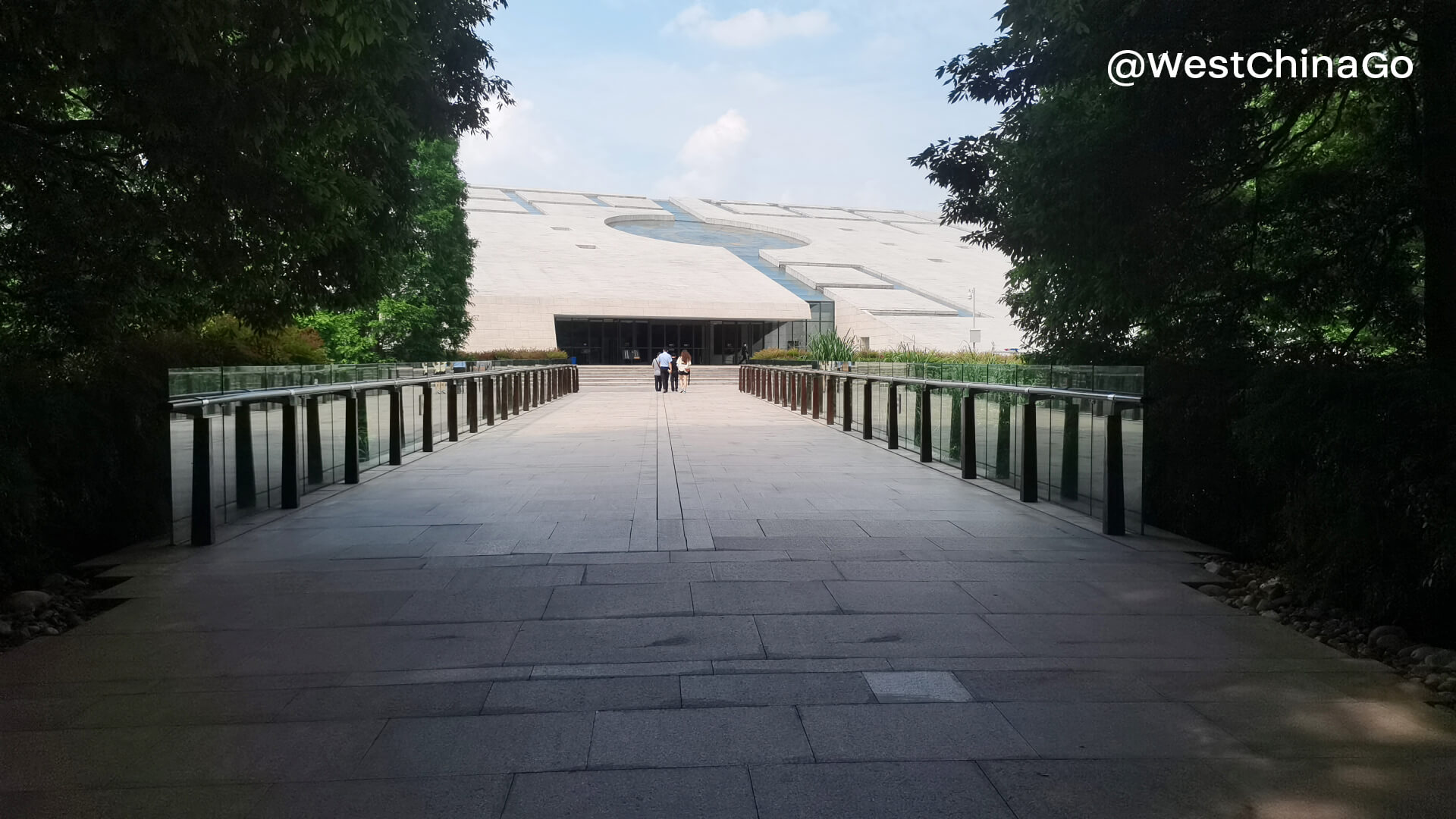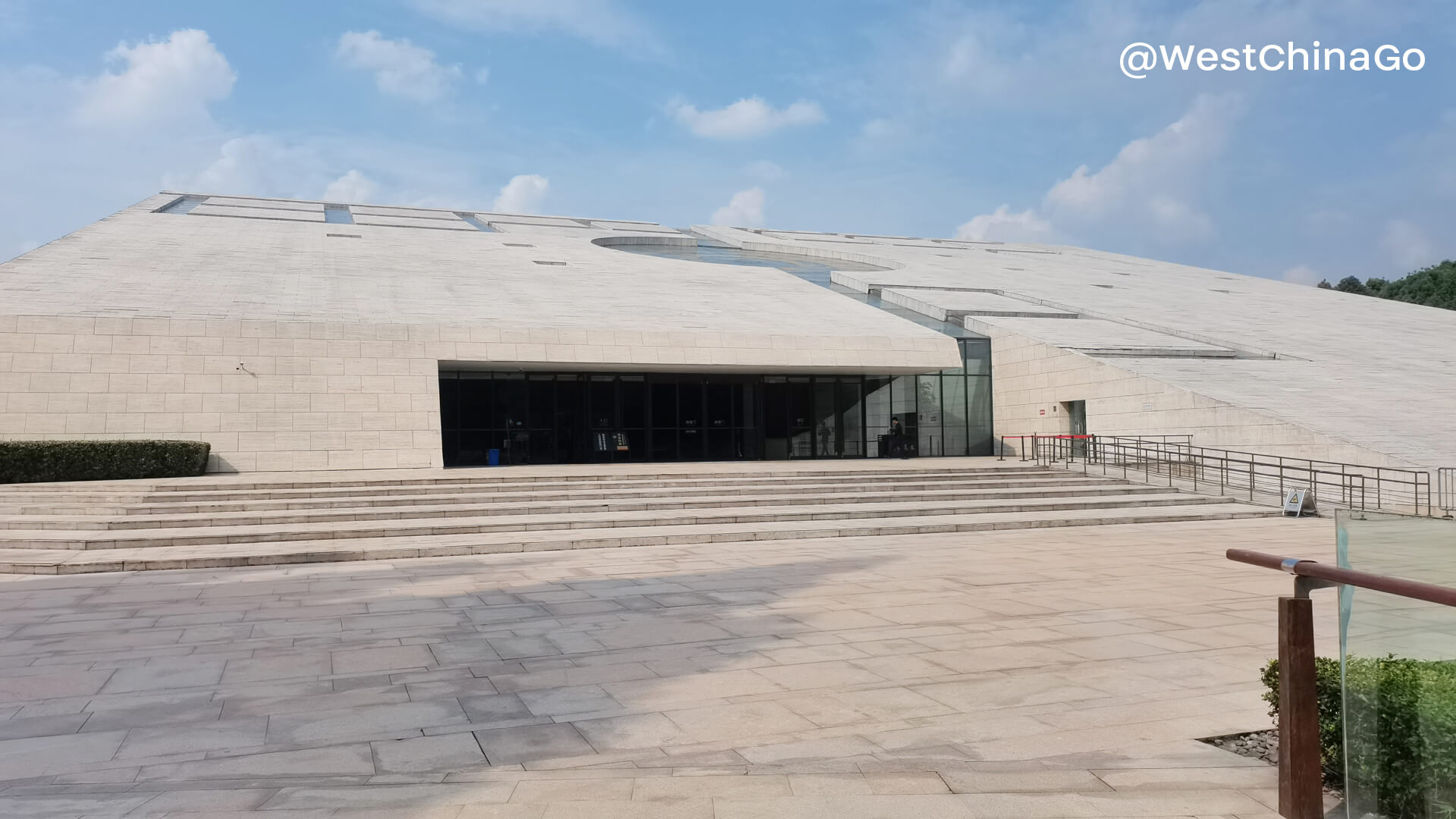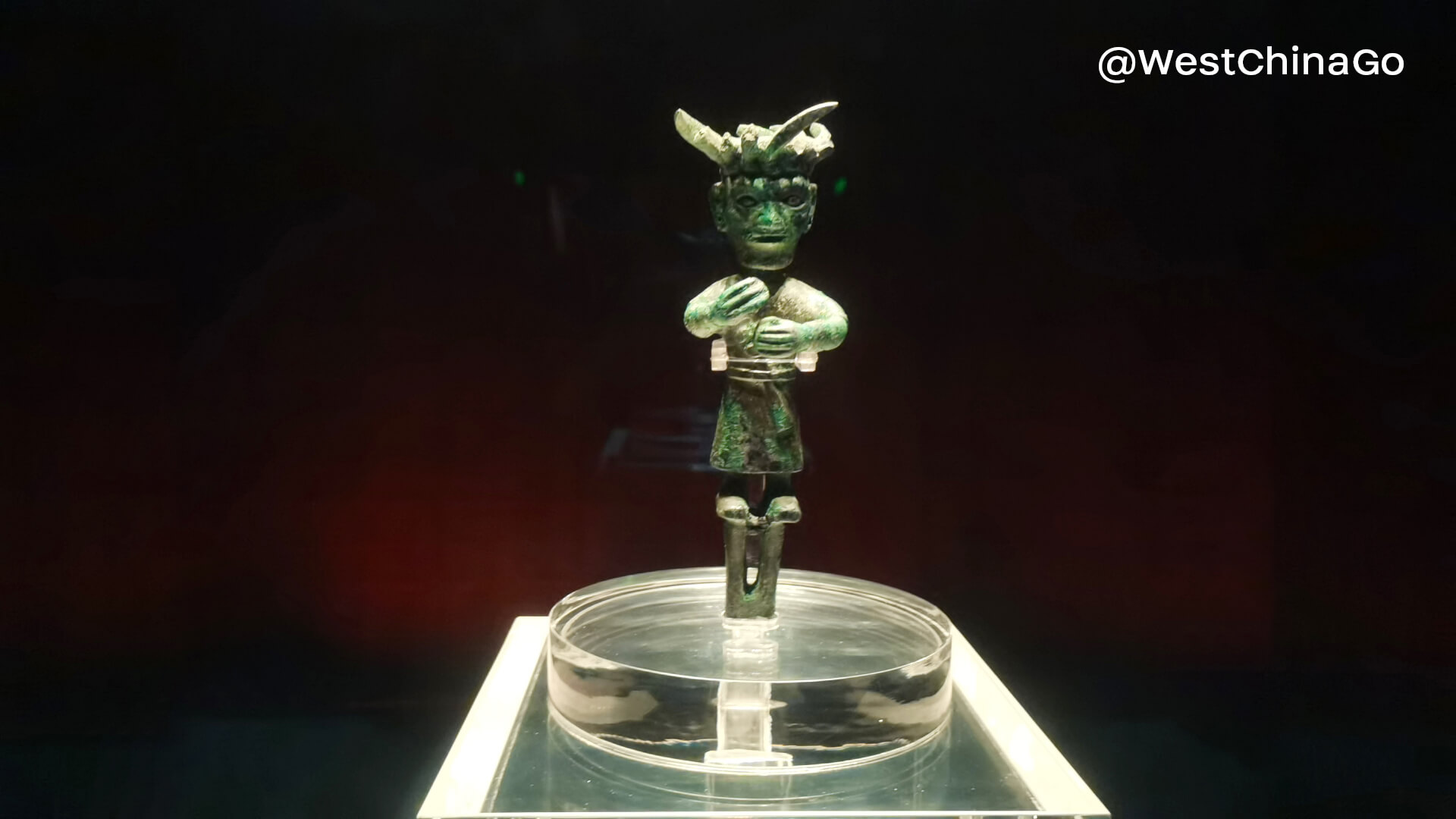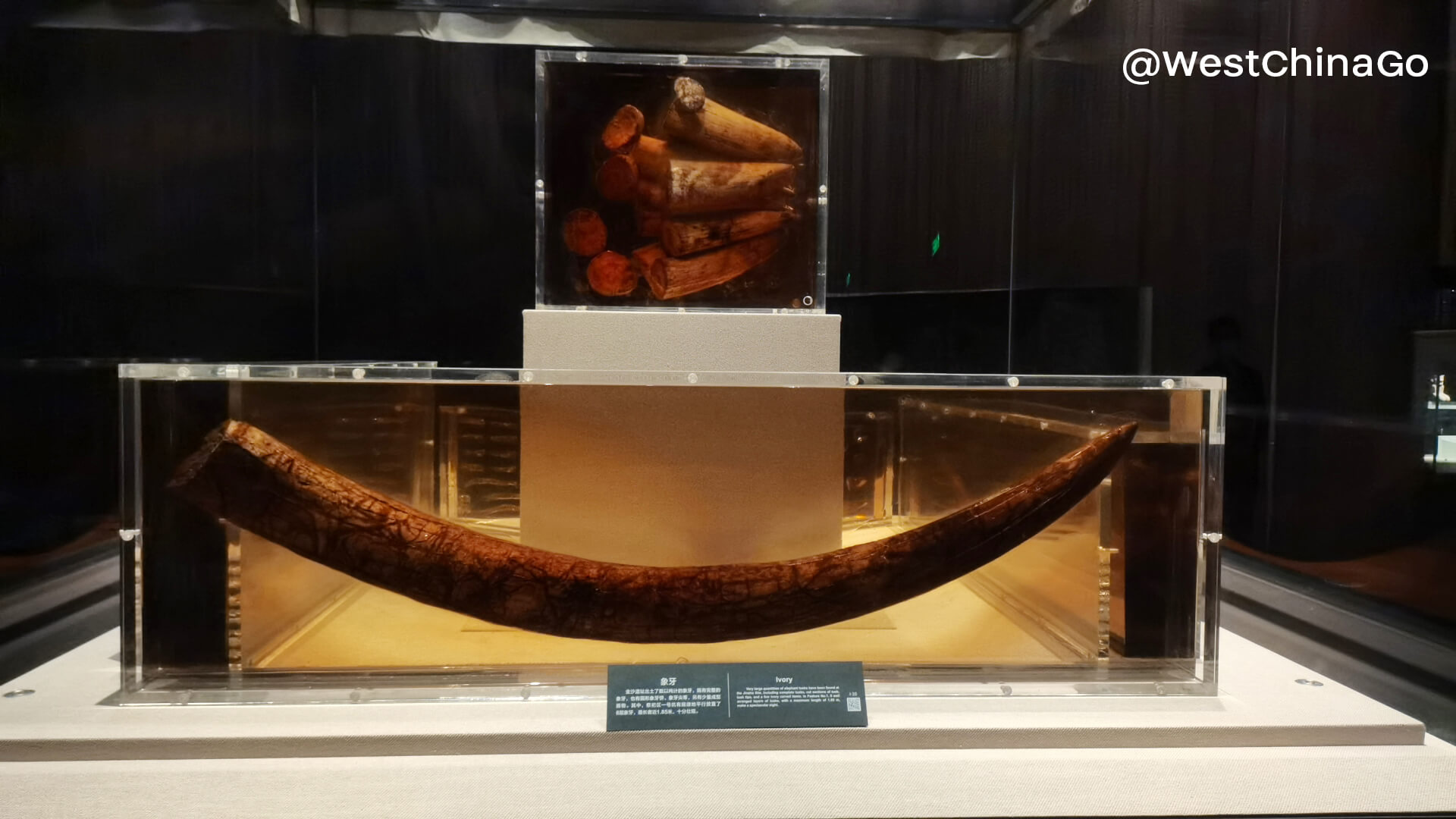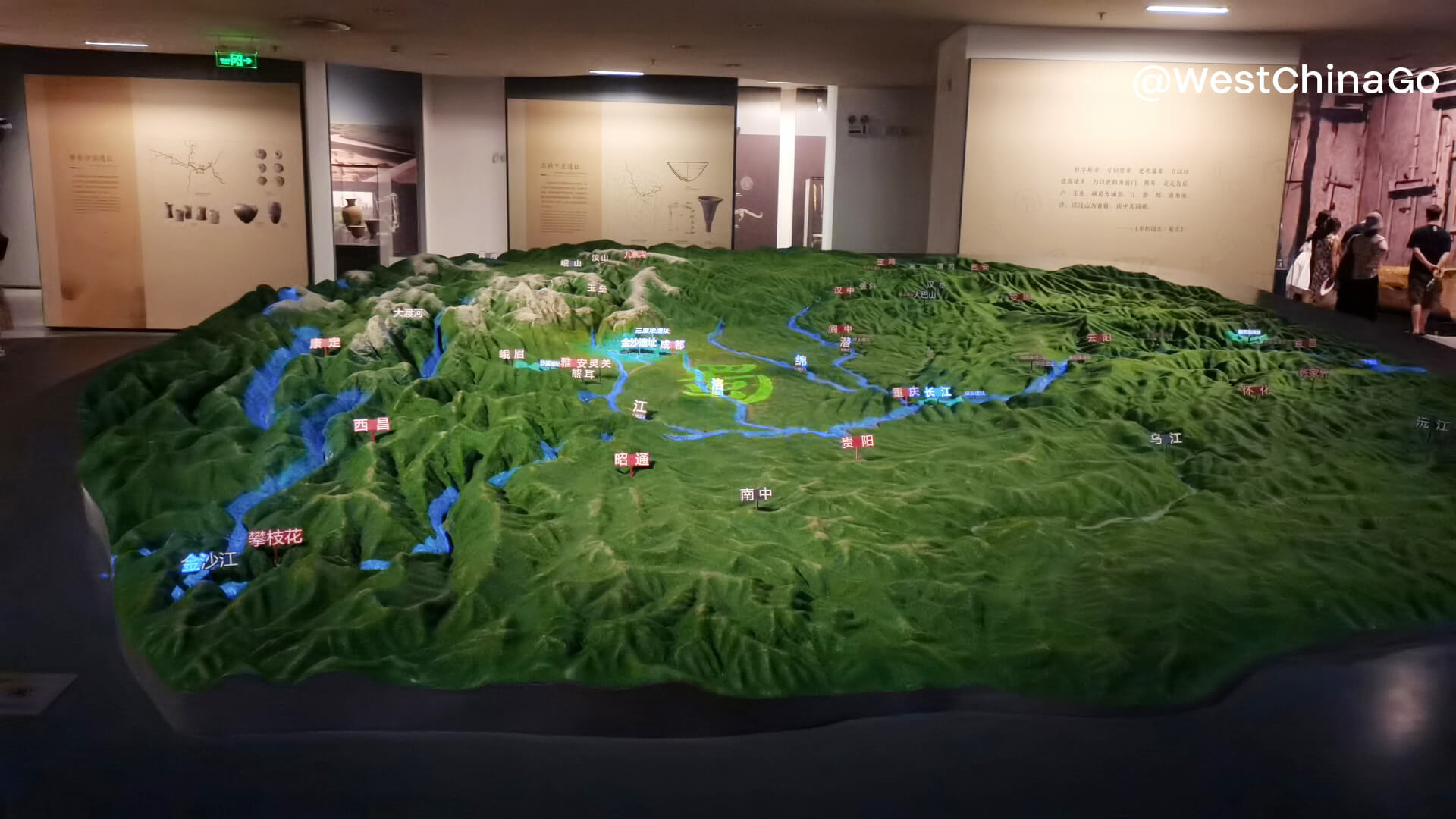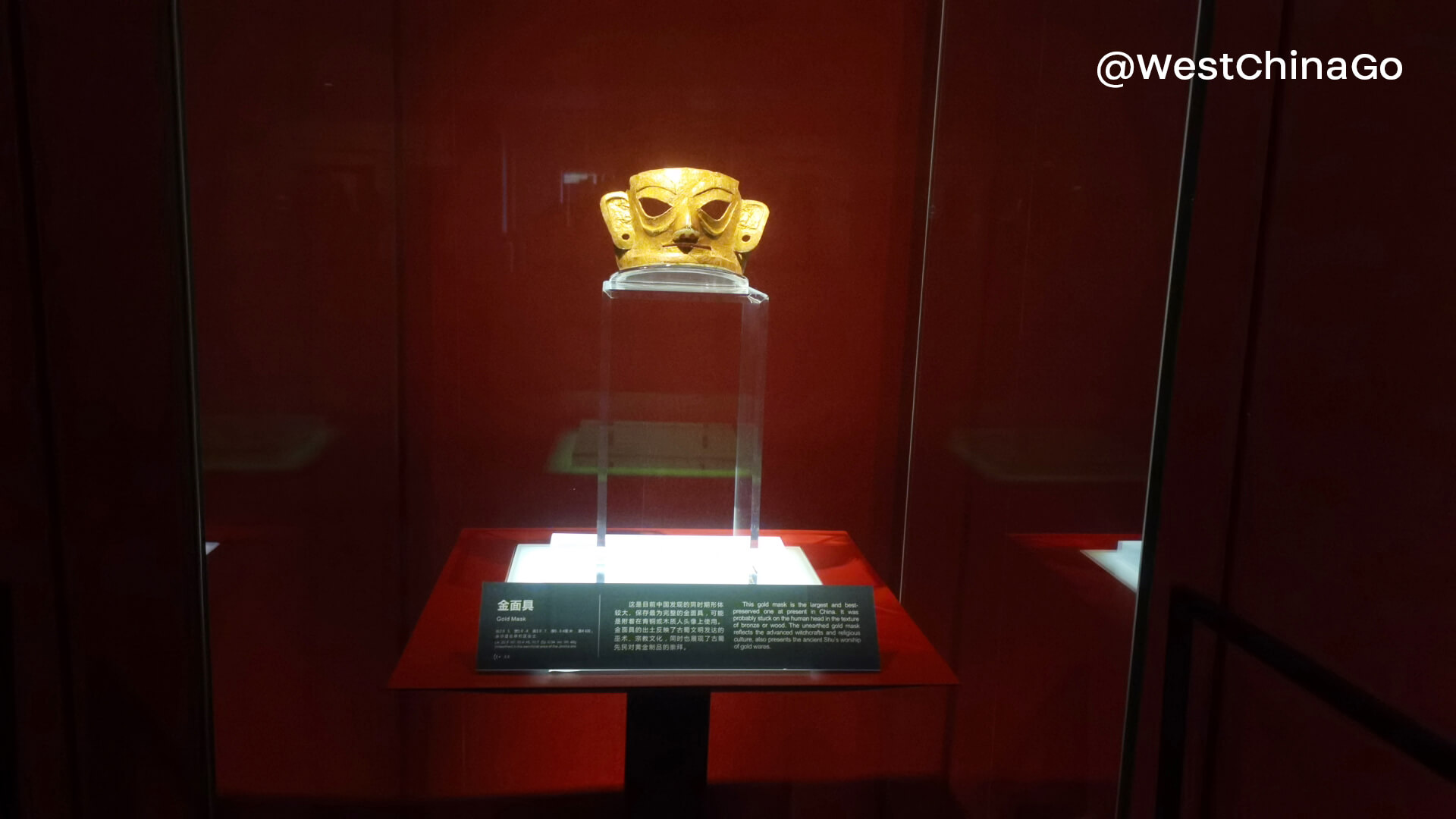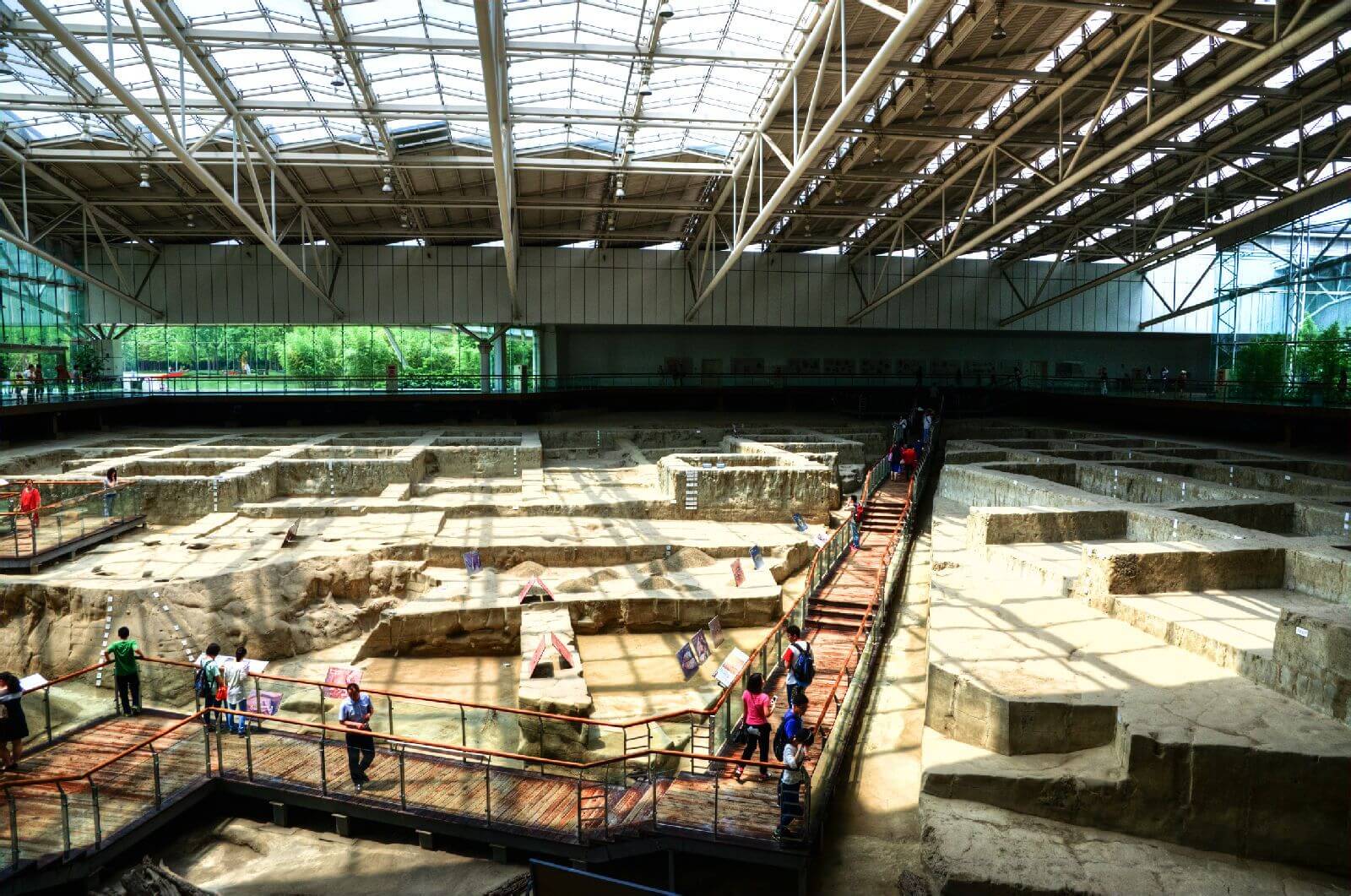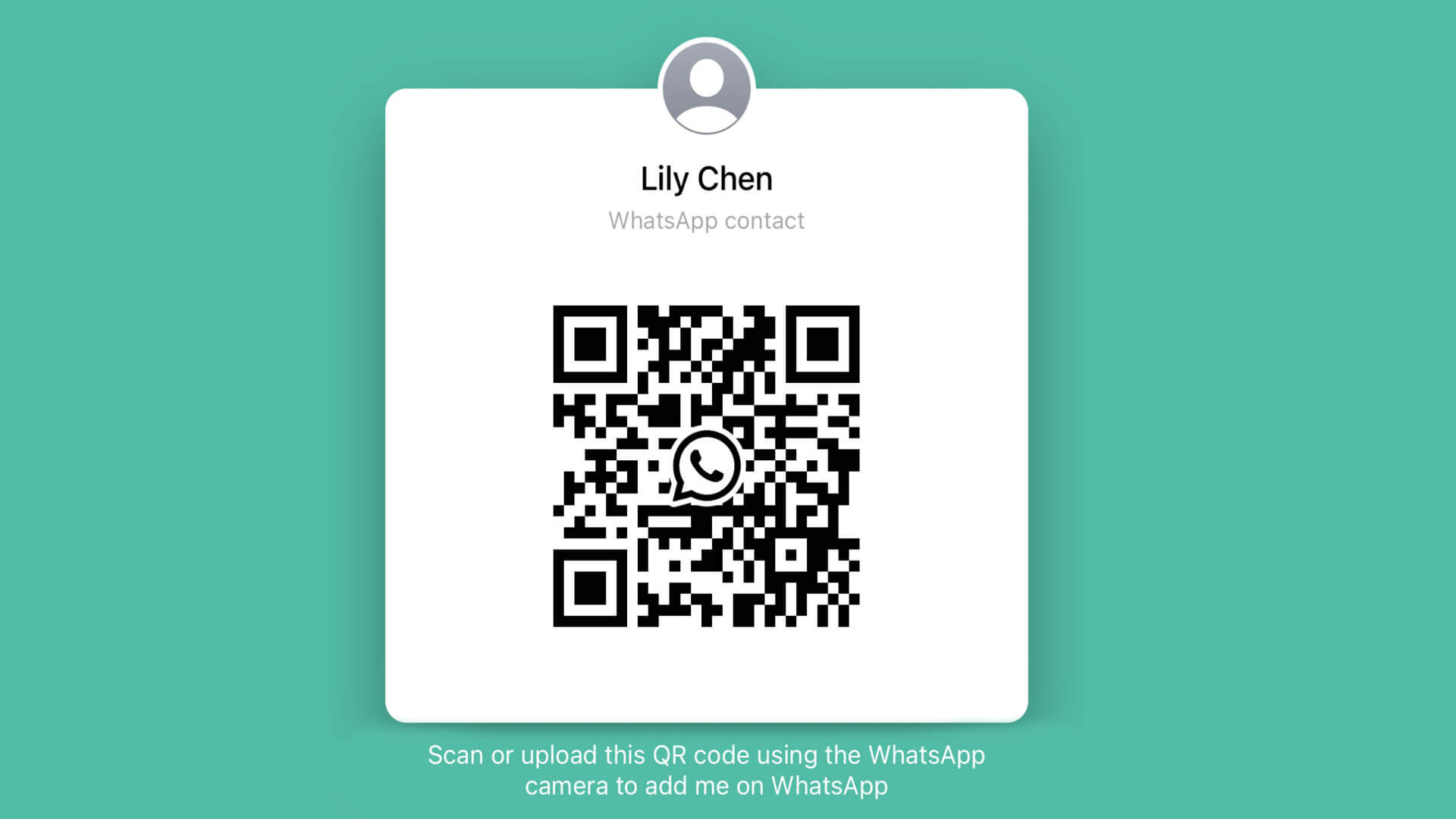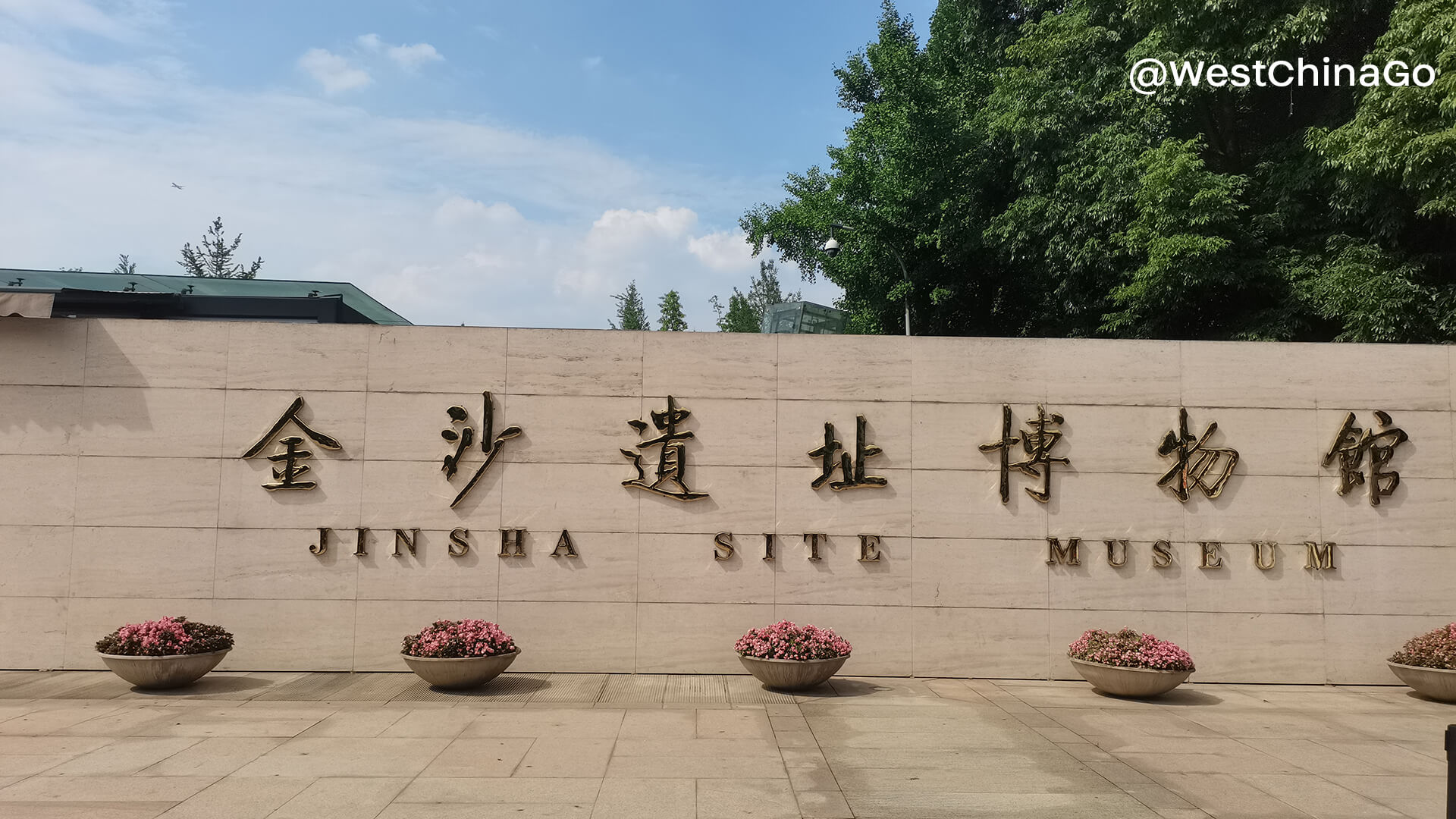
ChengDu Jinsha Site Museum
- Chinese Name:成都金沙遗址
- Address: 青羊区金沙遗址路2号,青羊大道227号
- Opening Time:08:00~18:00 (close at monday)
- Recommended Visiting Time:2 hours
- Tickets 80 CNY/Person (1-10 人讲解50 元,租用语音导览器10 元/ 次;)(1-10 people explain 50 yuan, rent an audio guide 10 yuan / time;)
- offical website: www.jinshasitemuseum.com
- phone: +86 028-87303522
- 4D 影院门票20 元/ 人;《金沙》音乐剧乙票180 元;甲票280 元;特票380 元;VIP 票580 元
- 4D cinema tickets 20 yuan per person; “Sands” musical B ticket 180 yuan; A ticket 280 yuan; special ticket 380 yuan; VIP ticket 580 yuan
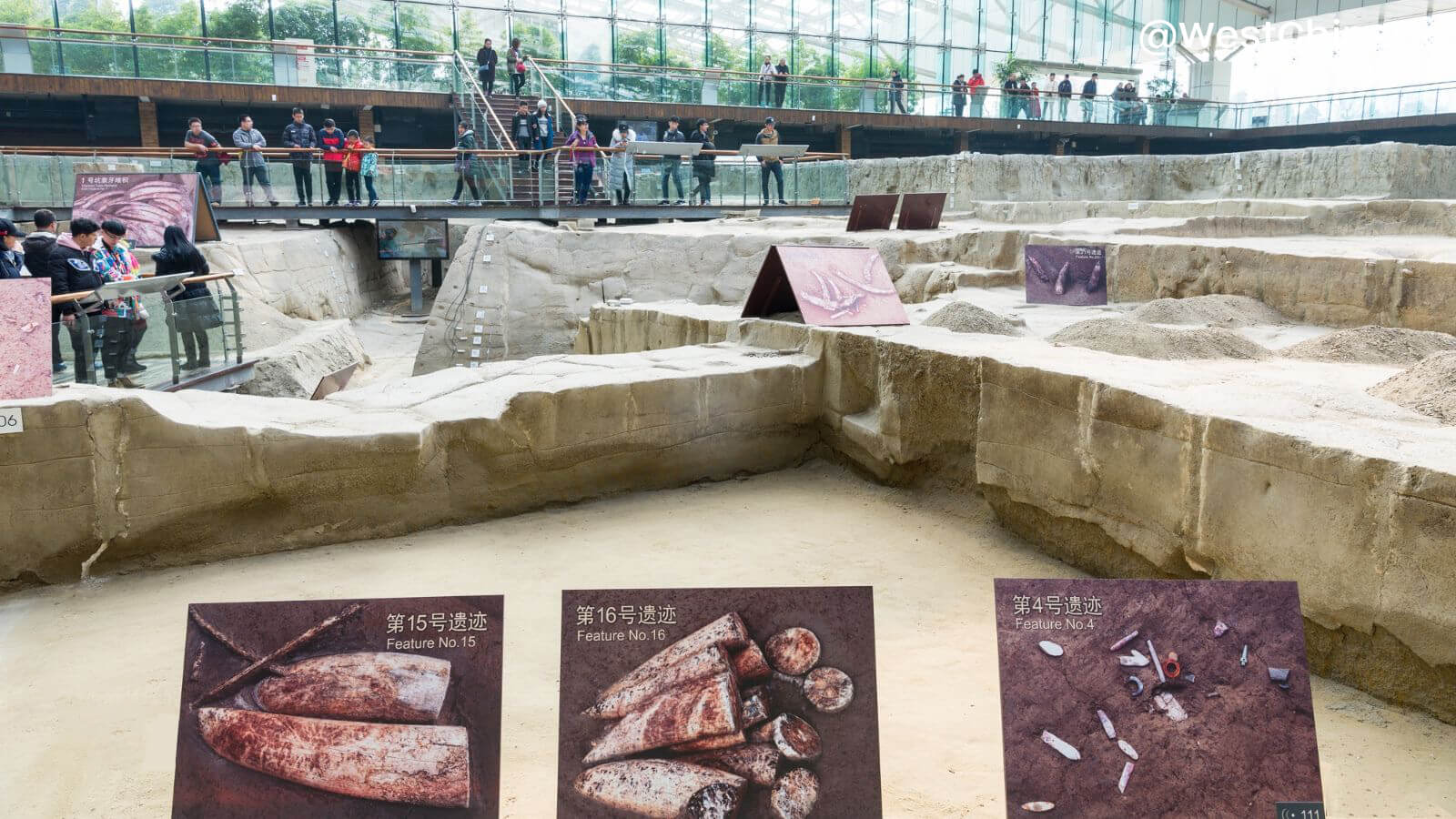
Chengdu Jinsha Site Museum
The Chengdu Jinsha Museum is a must-visit destination for history buffs and anyone interested in ancient Chinese civilization.
It is a large-scale archaeological site museum that showcases the ancient Shu culture and civilization of Sichuan Province.
The museum is situated in the Jinsha Ruins, which were discovered in 2001 during a construction project.
The ruins are believed to date back to the Shang and Zhou dynasties (1600-316 BC) and are considered to be one of the most significant archaeological discoveries in China in recent years.
The museum features a vast collection of artifacts, including jade, pottery, bronze, and gold artifacts, as well as human and animal
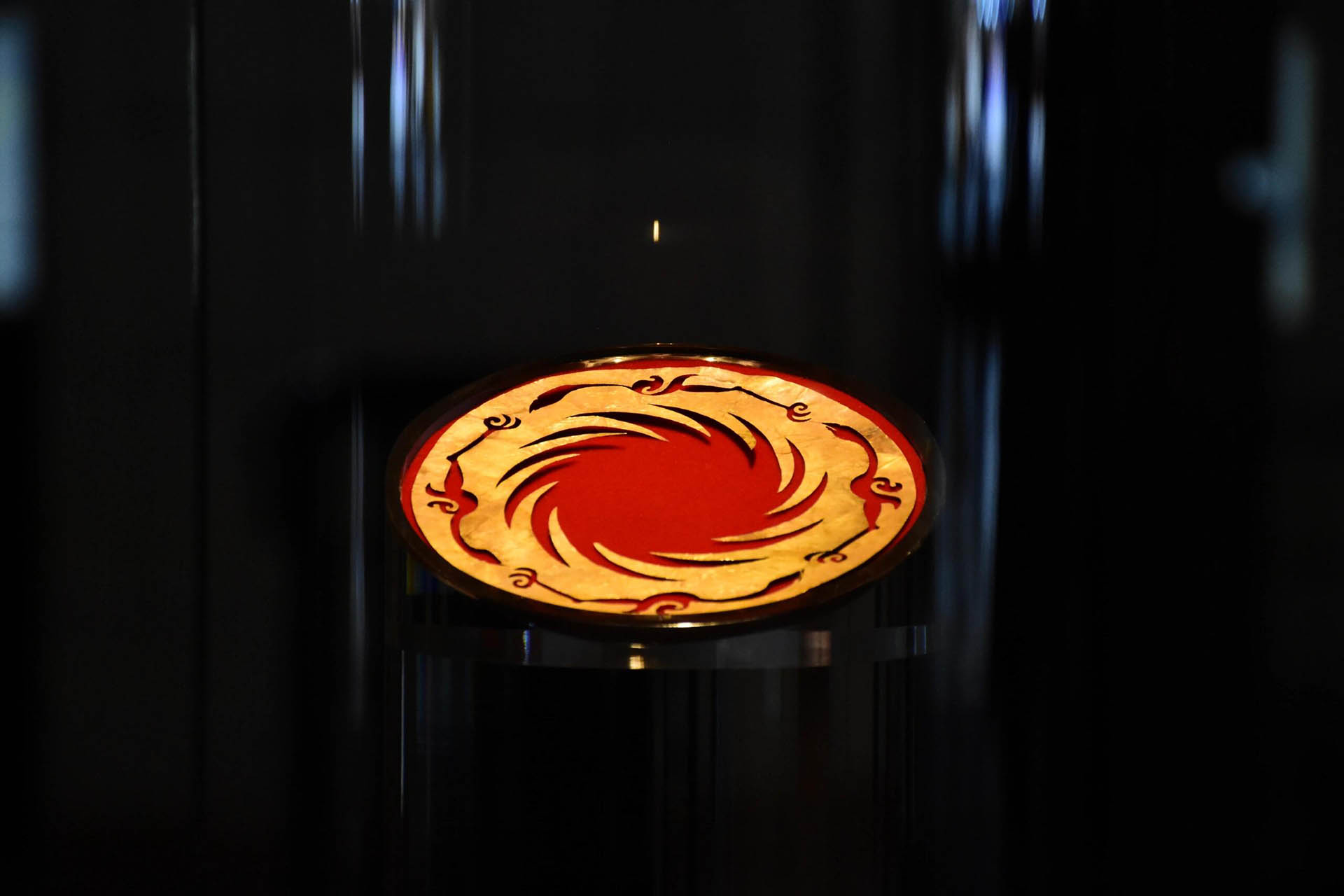
Chengdu Jinsha Site Museum Photo
Chengdu Jinsha Site Museum Video
Things to do
1.Explore the exhibition halls
- Jinsha Museum has three exhibition halls, where you can see various ancient artifacts and relics, including bronze ware, jade, gold, and pottery.
- You can learn about the history of the Shu culture and its civilization, which dates back more than 3,000 years.
2.Visit the Jinsha Site Archaeological Excavation Site
- This is an outdoor exhibit area that showcases the archaeological excavations of the Jinsha site.
- You can see the remains of ancient buildings, drainage systems, and other structures that reveal the history of the Shu civilization.
3.Watch the multimedia shows
- The museum has several multimedia shows that provide an immersive experience of the Shu culture.
- You can watch a 360-degree projection show that depicts the ancient Shu kingdom or watch an animated movie that tells the story of the Jinsha site’s discovery.
4.Enjoy the beautiful landscape
- The museum is surrounded by beautiful gardens and a lake, which provide a serene environment to relax and enjoy the scenery. You can take a stroll around the gardens or have a picnic with your family and friends.
5.Shop at the gift store
- The museum has a gift store where you can buy souvenirs, such as postcards, books, and replicas of ancient artifacts. You can take home a piece of the Shu culture as a memory of your visit to the museum.
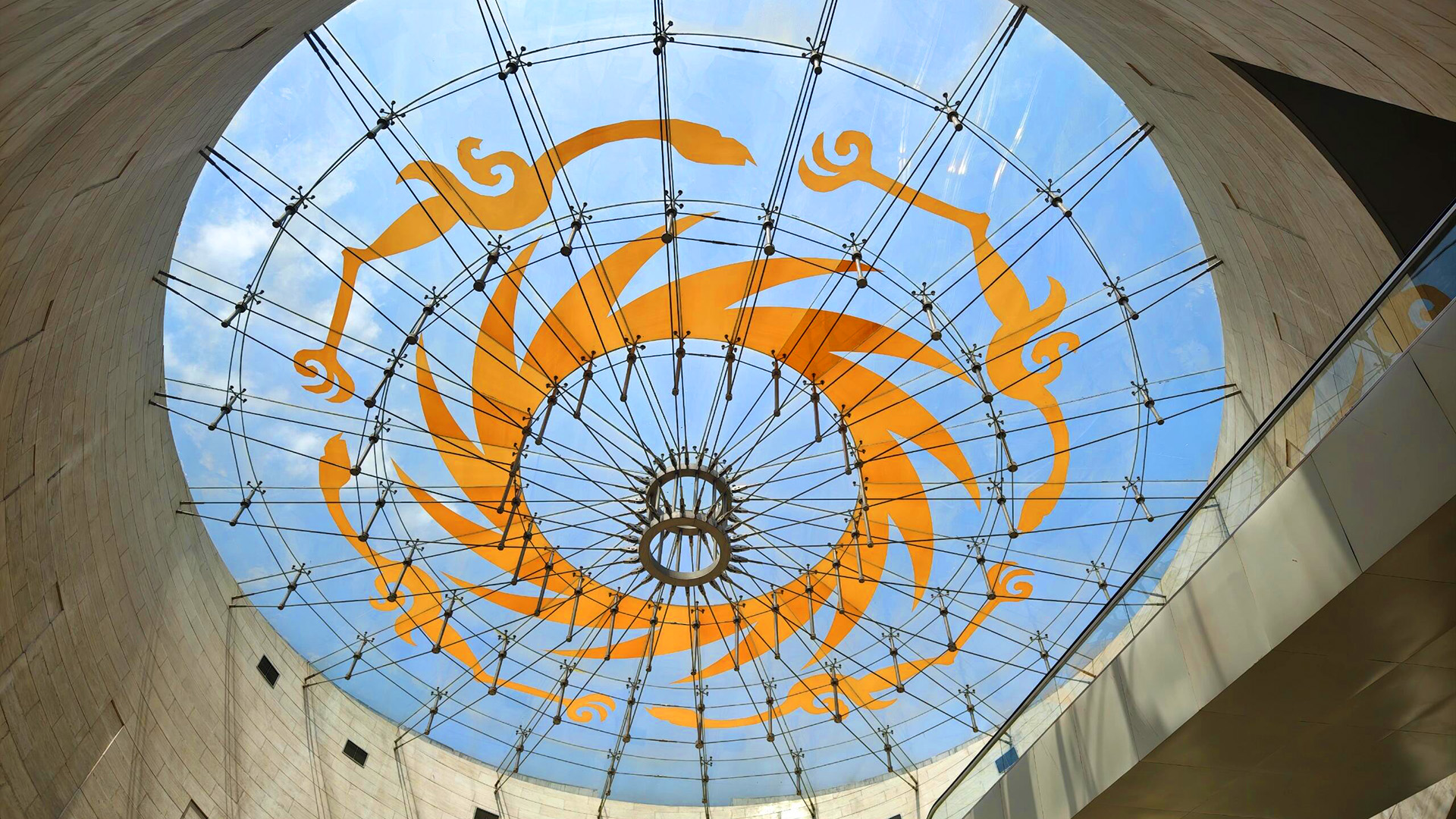
ChengDu Jinsha Site Museum
Chengdu Jinsha Site Museum, a national first-class museum, covers an area of 456 acres and a building area of 38,000 square meters
It is a relic museum built for the protection, research and display of Jinsha culture and ancient Shu civilization
The Chengdu Jinsha Site Museum has a total of 2,235 pieces (sets) of cultural relics in the collections of gold, bronze, jade, stone, lacquered wood, pottery, and ivory. Among them, there are 366 first-level cultural relics (sets), 374 second-level cultural relics (sets), and 1,429 third-level cultural relics (sets).
The Exhibition Hall with the coverage of 16,000 square meters is built into sloping-roof and steel-framed square structure in the north of Modihe River. It has 5 exhibition rooms with the theme of Primitive Homeland, King Palace at a Glance, Immortal Heaven and Earth, Peak of Perfection and Seeking Answers to the Mysteries of Jinsha, displaying the brilliance and glory of ancient Jinsha by the modern technology in different visual angles such as the eco-environment, architecture style, production and living, funeral custom and religious worship activity.
Here, you can see the 4D film Dreaming Back to Jinsha. It could bring you to traverse the space-time back to 3,000 years to see the brilliant ancient Shu kingdom from Duyu Dynasty to Kaiming Dynasty. The Exhibition Hall also offers service facilities, such as Press Briefing Room, Academic Lecture Room, Jinsha Souvenir Shop, Flavor of Jinsha Restaurant Bar, Information Desk, and Deposit Center.
In December, 2011, the pattern of The Sun and Immortal Bird Gold Ornament has been selected as core pattern of City Logo Design of Chengdu. Today, Jinsha Site Museum is not only the symbolic cultural landscape of profound Chengdu history, but also the indispensable exhibition of ancient Shu civilization, social education base for adolescents, and leisure place for tourists’ visiting. Since opening to the public on April 16th, 2007, we have done the utmost to honor our mission that let people step into Jinsha and let Jinsha go to the world, and up till now, the museum has received 5 million visitors from home and abroad.
Jinsha Site Museum
❶The Jinsha Site was found in February 2001 in urban Chengdu. It covers 5 square-kilometers, and dates back to 12th to 7th century B.C. (approximately 2900 – 3200 years ago). It was the capital of the ancient Shu Kingdom, which is considered to be the ancient civilization center along Yangtze River. It is the first major archaeological discovery in China at the beginning of the 21st century, and also a significant archaeological event following the discovery of the Sanxingdui site in Sichuan Province. Therefore, it has become one of the Ten Major Archaeological Discoveries of China in 2001.
❷So far, archaeologists have unearthed important features of large-scale palace foundation, sacrificial area, residential area, and burial site. On the site, a great variety of artifacts in large numbers were unearthed, including more than 5,000 articles of gold, bronze, jade, stone, ivory, and lacquered wood, as well as millions of pottery potsherds, tons of ivory and thousands of boar tusks and deer horns. Therefore, it is considered that the Jinsha Site has unearthed the richest gold and jade wares and the densest elephant tusks in the world. At present, it can be confirmed that after the decline of Sanxingdui civilization, Jinsha Site should be another arisen center of politics, economy and culture in Chengdu Plain mainly from late Shang Dynasty to Western Zhou Dynasty, and also one of the most important archaeological sites of Pre-Qin period in China.
❸The discovery of Jinsha Site is of great significance for the study of Shu culture, including its origin, development, and decline, and provides convincing evidence for an explanation of the abrupt disappearance of Sanxingdui culture. Jinsha Site revives the lost glory in history, and unveils the prosperity of ancient Shu kingdom.The site, together with the ruins of prehistorical cities in Chengdu Plain, the Sanxingdui site and the canoe-shape coffin graves of the Warring States period, represent the four different stages of ancient Shu culture. The discoveries not only have proved that the Chengdu Plain was the center of ancient civilization in the upper reaches of the Yangtze, and an important component of Chinese civilization, but also provide crucial evidence to the theory that the origins of ancient Chinese civilization is a unity of pluralism.
The discovery of Jinsha Site has pushed forward the Chengdu history from 2,300 years ago to 3,000 years ago, which offers an opportunity to improve the popularity of Chengdu, the Historical and Cultural City of China. Since the discovery was unknown to the public, the CPC and the state leaders have attached great importance to the work in Jinsha Site. The central leaders of China have inspected the site successively, and indicated to continue good job on excavation, conservation and construction of the site. Lots of famous experts have also come here to investigate and offer suggestions on the work of the site.
Chengdu Jinsha Site Museum
After discovery, all levels of party committee have drawn great attention to the conservation work of site and construction work of the museum. In April, 2007, the Jinsha Site Museum with 3,000 years’ history of Chengdu has completed to build on the original site. This is a site museum for the conservation, study and exhibition on Jinsha culture and ancient Shu civilization, which is composed of Relics Hall, Exhibition Hall, Tourist Center, Preservation and Restoration Center, Jinsha Theatre and Heritage Park with total coverage of 300,000 square meters and floor area of 38,000 square meters. Moreover, it is also the modern garden-type museum with the function of education, research, and recreation, and also the symbolic landscape for the profound history of Chengdu.
The Museum has two main constructions by both sides of Modihe River, Relics Hall and Exhibition Hall, which is the implementation of the idea of round sky and square earth for architectural features,and regarded as the landmark building of Chengdu. Relics Hall covering an area of 7,588 square meters is built into sloping-roof and steel-framed semi-circle structure in the east of museum and the south of Modihe River.
Relics Hall is the excavation site located on the ruins of ancient sacrificial area, and also the best-preserved site with the longest history and largest amounts of cultural relics. The site is protected originally, so that the tourists can sense the magnificent scene of sacrificial ceremony held by ancient Shu kingdom along the river 3,000 years ago.Moreover, you can acquaint yourself with the meticulous and complicated excavation work from 2001 to now on the spot where the precious cultural relics are unearthed.
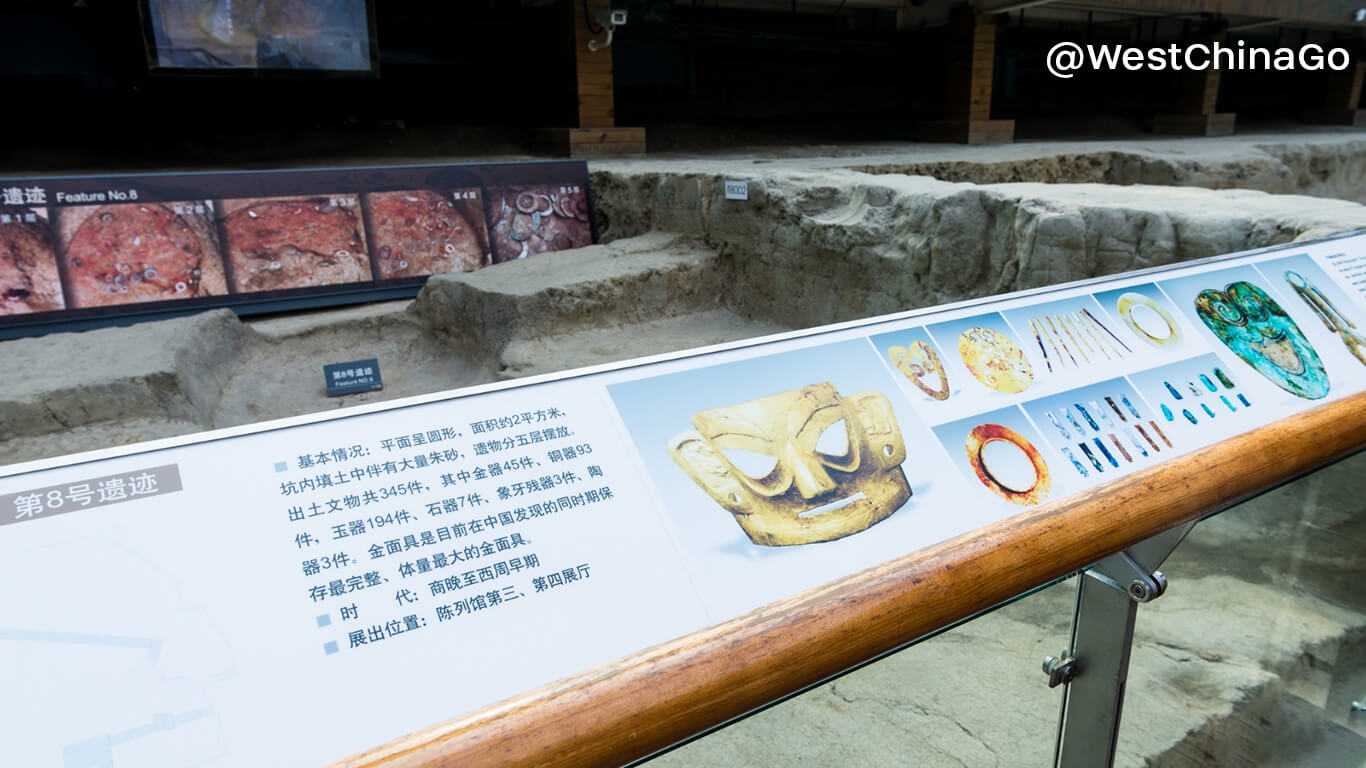
Chengdu Jinsha Site Museum Tourist Map
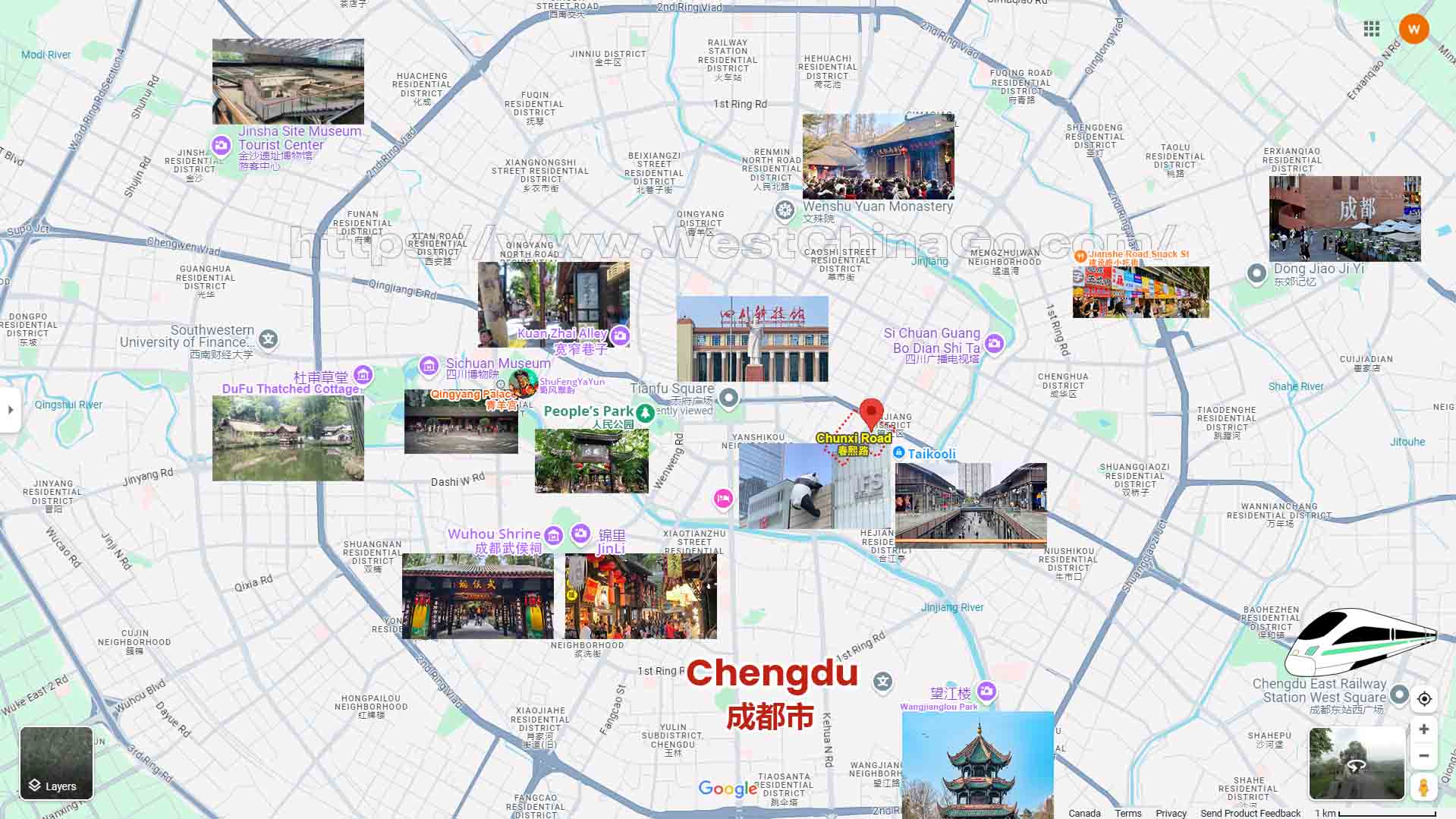
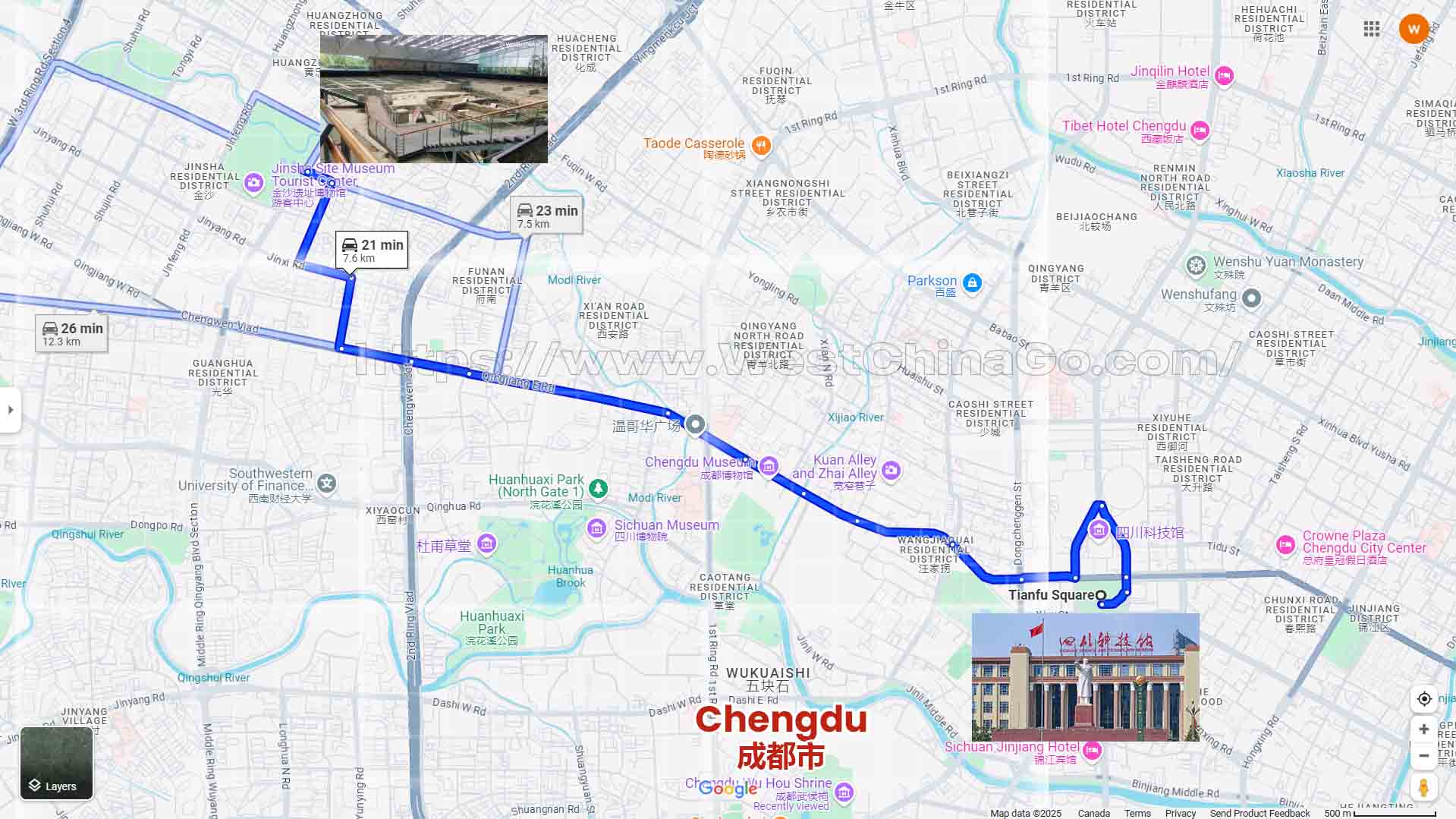
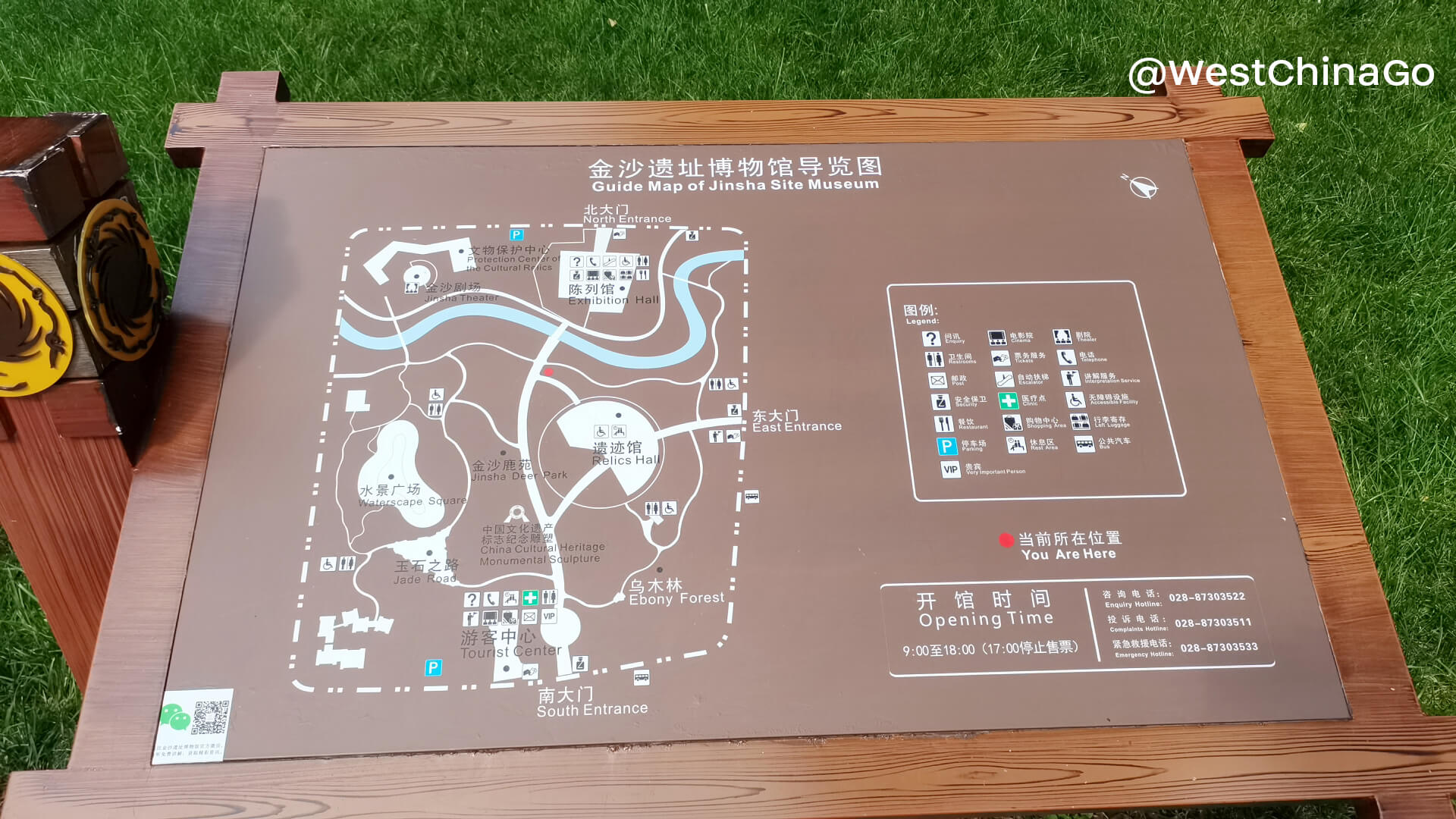
How To Get To Chengdu Jinsha Site Museum
By Taxi
Practical Chinese:for taxi driver pls take us to Chengdu Jinsha Site Museum 请载我们到成都金沙遗址博物馆By Subway
Take Subway Line 7, Jinsha Site Museum Station, Exit C Or Take Metro Line 2 Yipintianxia Station Exit B, get off and walk for about 10 minutes
Chengdu metro map